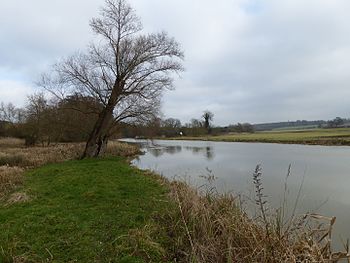
Northamptonshire is a county in the East Midlands of England.[1] It has an area of 236,700 hectares (914 sq mi)[2] and a population estimated in mid-2016 at 733,000.[3] The county is bordered by Warwickshire, Leicestershire, Cambridgeshire, Bedfordshire, Buckinghamshire, Oxfordshire, Rutland and Lincolnshire.[4] It was governed by Northamptonshire County Council and seven district and borough councils, Corby, Daventry, East Northamptonshire, Kettering, Northampton, South Northamptonshire and Wellingborough[5] but since 1 April by the unitary authorities of North Northamptonshire and West Northamptonshire. The county flower is the cowslip.[6]
A ridge of low Jurassic hills runs through the county, separating the basins of the Welland and Nene rivers. The county has good transportation connections as it is crossed by two main railway lines and the M1 motorway, and it has many small industrial centres rather than large conurbations.[7]
In England, Sites of Special Scientific Interest (SSSIs) are designated by Natural England, which is responsible for protecting England's natural environment. Designation as an SSSI gives legal protection to the most important wildlife and geological sites.[8] As of July 2017[update], there are 57 sites designated in Northamptonshire,[9] 48 for their biological interest and 9 for their geological interest. Eight are Geological Conservation Review sites, four are Nature Conservation Review sites, and fourteen are managed by the Wildlife Trust for Bedfordshire, Cambridgeshire and Northamptonshire. The largest is Upper Nene Valley Gravel Pits, which is a Ramsar internationally important wetland site[10] and a Special Protection Area under the European Union Directive on the Conservation of Wild Birds.[11] The smallest is Irchester Old Lodge Pit, which is described in the Geological Conservation Review as a Middle Jurassic site of national importance.[12]
- ^ "List of all the places in East Midlands". Ordnance Survey. Archived from the original on 21 September 2017. Retrieved 21 September 2017.
- ^ "Standard Area Measurements (2016) for Administrative Areas in the United Kingdom". Office for National Statistics. Archived from the original on 10 April 2017. Retrieved 3 May 2017.
- ^ "Population Estimates for UK, England and Wales, Scotland and Northern Ireland". Office for National Statistics. Archived from the original on 15 February 2017. Retrieved 31 July 2017.
- ^ "GB Counties — Past and present". Ordnance Survey. Archived from the original on 11 July 2017. Retrieved 21 September 2017.
- ^ "District and borough councils". Northamptonshire County Council. Archived from the original on 21 September 2017. Retrieved 21 September 2017.
- ^ "Plant and fungi species: Cowslip". Plantlife. Archived from the original on 2 January 2017. Retrieved 3 May 2017.
- ^ "Northamptonshire". Encyclopædia Britannica. Archived from the original on 22 April 2016. Retrieved 3 May 2017.
- ^ "Sites of Special Scientific Interest: Designation". Natural England. Archived from the original on 6 March 2016. Retrieved 19 April 2016.
- ^ "Designated Sites View: Northamptonshire". Natural England. Archived from the original on 20 August 2017. Retrieved 31 July 2017.
- ^ Cite error: The named reference
nenerwas invoked but never defined (see the help page). - ^ Cite error: The named reference
neneswas invoked but never defined (see the help page). - ^ Cite error: The named reference
iolpwas invoked but never defined (see the help page).